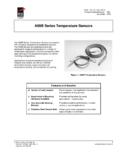Transcription of SERIES VS PARALLEL IRING - Electronics
1 SERIES VS. PARALLEL WIRING How to wire speaker cabinets SPEAKERS AND AMPLIFIERS If you ever consider wiring more than two speakers to a two-channel amplifier, or more than four speakers up to a four-channel amplifier, you need to concern yourself with your amplifier s ability to handle low-impedance loads. If you ignore the way you wire them together, chances are you will fry the amplifier. All that is needed for a successful hookup is for you to master two basic wiring concepts SERIES and PARALLEL . SPEAKERS WIRED IN SERIES When speakers are wired in SERIES : The more speakers, the higher the impedance The higher the impedance, the lower the acoustical output.
2 Always try to keep the total equivalent-load impedance for each channel below 16 ohms. Most amplifiers are not designed to handle anything higher than 16 ohms. TWO SPEAKERS WIRED IN SERIES The positive output terminal from one channel of the amplifier is wired to the positive terminal of Speaker A, and the negative terminal of Speaker A is connected to the positive terminal of Speaker B. A loop is created by wiring the negative terminal of Speaker B to the negative output terminal of the same amplifier channel. Speaker A Speaker B SERIES MORE THAN TWO SPEAKERS To wire more than two speakers in SERIES , you simply continue alternating the negative and positive wires between speakers.
3 To wire four speakers: Connect the negative terminal of Speaker B to the positive terminal of Speaker C Connect the negative terminal of Speaker C to the positive terminal of Speaker D, etc. HOW TO CALCULATE THE LOAD IMPEDANCE FOR SERIES Formula Zt = Za + Zb Example You want to install 4-15in subwoofers in your car. The amplifier delivers 100 watts x 2 channels into 4 ohms and can drive a min. impedance of 4 ohms. The subs are rated at 4 ohms each. Wire each pair of speakers in SERIES , bringing the ohms of each channel to 8. Zt = 4 + 4 Zt = 8 ohms POWER CALCULATIONS It is important when connecting more than one speaker to an amplifier channel to know how much power each speaker will receive.
4 Knowing this can save you the costly damage of blowing a speaker. Referring to the same subwoofer scenario: The power output is equal to the amp s power rating times (the impedance of the amp s output power divided by the equivalent-load impedance for each channel) Po = Pr x (Zr/Zt) POWER CALCULATIONS - CONT Po = Pr x (Zr/Zt) Po = 100 x (4/8) Po = 100 x Po = 50 watts This means that each channel will deliver 50 watts to an 8-ohm load. How much power will be applied to each speaker? Pa = Po x (Zn/Zt) with Zn standing for the rated impedance of the speaker Pa = 50 x (4/8) Pa = 25 watts Each subwoofer is rated 4 ohms Each speaker is receiving 25 watts WIRING A SERIES SPEAKER CABINET SUMMARY: For speakers in SERIES , you add the impedances of the speakers together.
5 To determine the wattage, you add the wattage of the speakers together If you were using 2-8ohm speakers, you d have a 16 ohm cabinet. If you were using 2-200 watt speakers, you d have 400 watts of power handling. SPEAKERS WIRED IN PARALLEL PARALLEL wiring has the opposite effect of SERIES wiring. Load impedance drops; therefore, the more speakers you wire in, the lower the impedance. Lower impedance raises acoustical output. Speaker output increases because the amplifier s power output rises as the load impedance decreases. Load impedance should be held to a minimum of 2 ohms. (If the amp can go that low) PARALLEL WIRING The positive terminal of one channel is wired to the positive terminals on speakers A and B.
6 The negative terminal of the same amp channel is wired to the negative terminals on speakers A and B. CALCULATING THE LOAD IMPEDANCE FOR A PARALLEL -WIRED CHANNEL You multiply the impedances of each speaker and then divide the result by the sum of the speakers impedances. Example: You have an amp rated at 4-ohm power (100 watts x 2), and is also 2-ohm stable. Zt = (Za x Zb)/(Za + Zb) Zt = (4x4)/(4+4) Zt = 16/8 Zt = 2 ohms CALCULATING THE POWER OUTPUT INTO 2 OHMS Po = 100 x (4/2) Po = 200 watts By wiring in PARALLEL , our power output is increased fourfold from 50 watts x 2 to 200 watts x2. The power applied to each speaker is calculated: Pa=Po x(Zt/Zn) Pa = 200 x (2/4) Pa = 100 watts Each 4 ohm speaker would receive 100 watts PARALLEL CABINET SUMMARY If speakers of equal impedance: You divide the impedance value by the number of speakers To determine the wattage, you add the wattage of the speakers together.
7 Ex: If you wire 4-16 ohm speakers in PARALLEL , you would have a 4 ohm cabinet. 2-16 ohm speakers in PARALLEL would give you an 8 ohm cabinet. If you were using 4-100 watt speakers, you have 400 watts power handling. SERIES / PARALLEL WIRING This type of wiring allows you to increase the number of speakers you can use in your system. Any number of speakers can be linked using a SERIES / PARALLEL wiring scheme provided you keep the total equivalent-load impedance between 2 and 16 ohms. SERIES / PARALLEL A wire runs from the amp s positive terminal, connects to the positive terminals of speakers A and C. Next, the negative terminals of Speakers A and C are wired to the positive terminals of Speakers B and D.
8 Finally, the loop is created by running a single wire from the negative terminal of the amp channel and splitting it between the negative terminals of Speakers B and D. SERIES / PARALLEL WIRING To wire speakers in SERIES / PARALLEL , all speakers should be the same impedance and wattage. The impedance of the cabinet will be the same as one of the speakers and the wattage will be 4 times the individual speaker wattage. If you were using 4-8 ohm speakers in the cabinet, the cabinet would be rated 8 ohms. If you were using 100 watt speakers, the wattage for the cabinet would be 400 watts power handling. SOLID STATE AMPS - VS - TUBE AMPS Solid State Amps Power ratings change as the impedance changes The lower the impedance, the greater the power Tube Amplifiers Power ratings do not change as the impedance changes There is no power handling advantage to wiring speakers in SERIES , PARALLEL , or SERIES / PARALLEL when using a tube amplifier.
9










